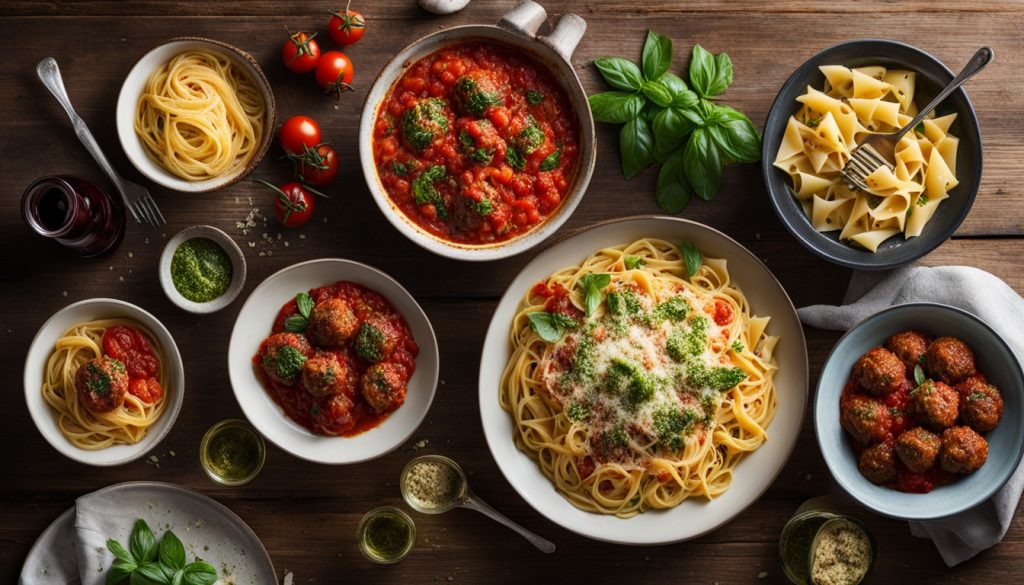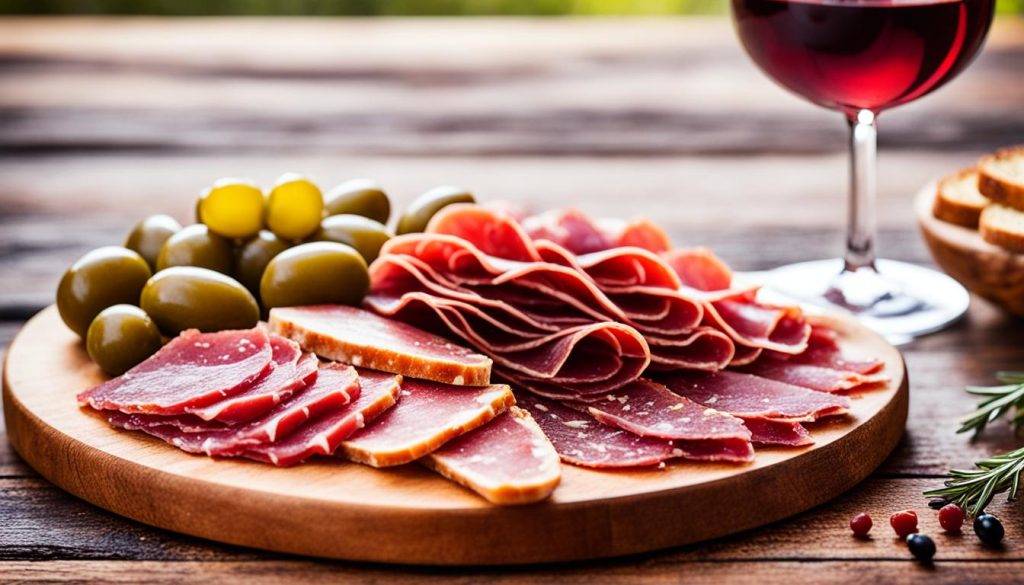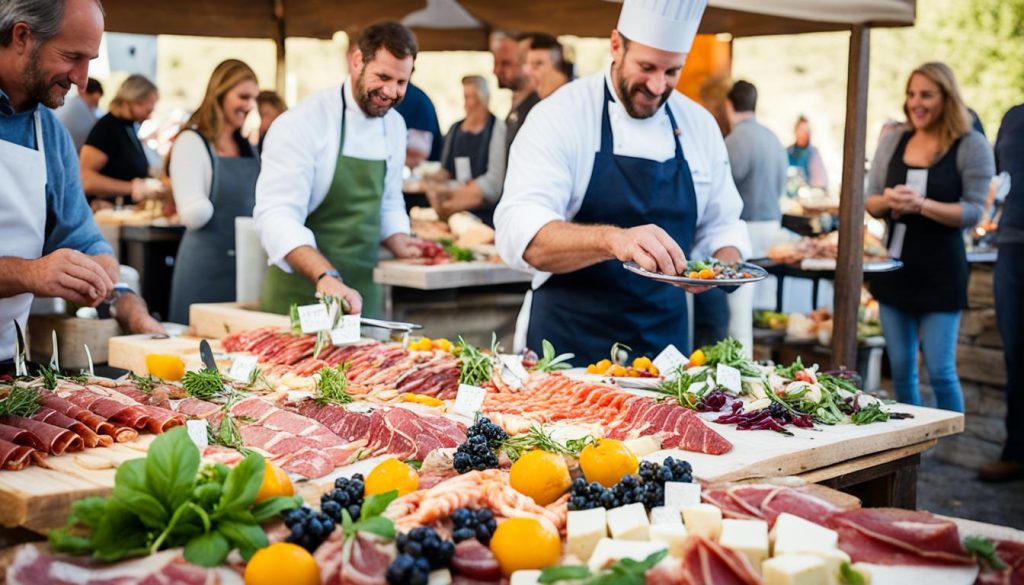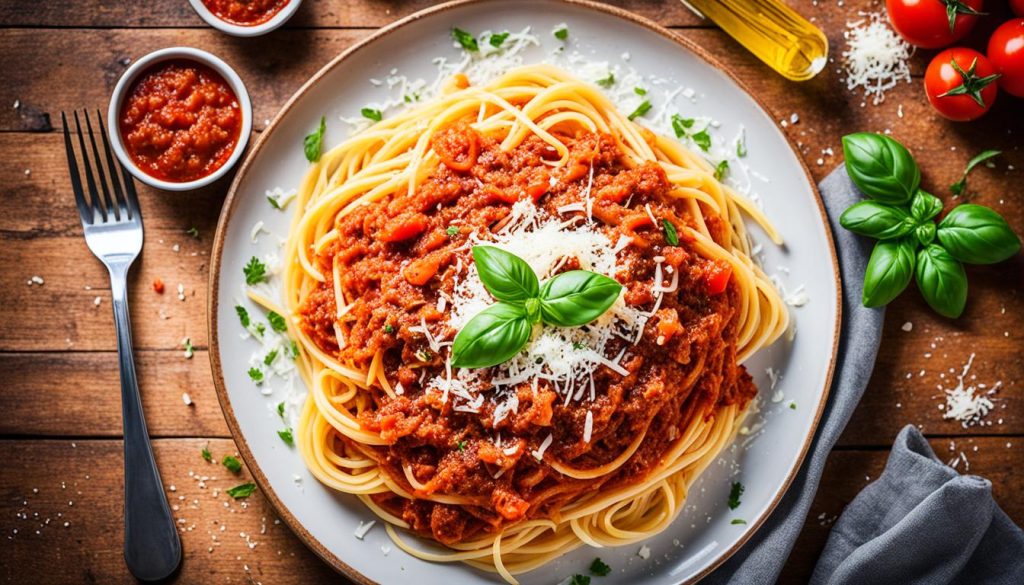We’re going to explore the rich tastes and traditions of Italian food. From classic pasta to artisan cheeses and fine wines, Italian food is famous for its variety.
Italian food combines respect for tradition with a lively food scene. Every region in Italy has its own special dishes and cooking ways. This creates a mix of flavours and methods that have been kept alive for generations.
Italian cooking is all about using fresh, top-quality ingredients. The Amalfi Coast’s juicy tomatoes and Genoa’s aromatic basil show off the natural tastes of Italian food. These ingredients are the stars of every dish.
Italian pasta is a treat, from the fine spaghetti to the hearty lasagna. Whether it’s a simple spaghetti aglio e olio or a complex carbonara, pasta shows off Italy’s cooking skills. It offers a mix of tastes and textures for everyone.
Italian food isn’t just about pasta. It’s also about amazing cheeses. From creamy mozzarella to sharp Parmigiano-Reggiano, these cheeses show the skill of Italian cheesemakers.
Italian cured meats are another highlight. From tender prosciutto to strong salami, these meats are key to Italian food. They add depth and flavour to many dishes.
No Italian meal is complete without a sweet treat. Think tiramisu, cannoli, or panna cotta. These desserts are a feast for the taste buds, leaving a lasting impression.
Italian food is also famous for its fine wines. With some of the world’s best vineyards, Italy offers a wide range of wines. From bold Tuscan reds to bubbly Veneto prosecco, there’s a wine for every event.
Over the years, Italian food has changed and grown. From street food to breakfast treats, Italian culinary traditions keep evolving. They blend history and culture, delighting food lovers worldwide.
Next, we’ll look closer at Italian food, covering regional dishes, pizza making, cheeses, and more. Join us as we discover the wonders of Italian gastronomy.
Key Takeaways:
- Italian food offers a wide range of tastes and traditions.
- Every region in Italy has its own special dishes and cooking ways.
- Using fresh, high-quality ingredients is key to Italian cooking.
- Pasta, cheeses, cured meats, and desserts are central to Italian food.
- Italian wines come in many flavours and styles.
A Brief History of Italian Gastronomy
To truly understand Italian gastronomy, we must look at its rich history. Italian food has been shaped by many influences. These include ancient Roman and Greek traditions and the trading links of the Renaissance.
The story of Italian food starts with the ancient Romans. They loved simple, fresh food and balance. This love for good food helped create the dishes we know today. They introduced us to pasta and olive oil, which are still key to Italian food.
Italy’s geography and regional diversity have greatly influenced its food. Each region has its own special tastes and cooking ways. This means Italian food is incredibly diverse, showing off the country’s varied landscapes and cultures.
The Influence of Trade and Exploration
Italy sits at the crossroads of Europe, Asia, and Africa, making it a centre of trade and cultural exchange. This has brought new foods and cooking ways to Italy. For example, the Silk Road brought spices and exotic fruits from the East, adding to Italian dishes.
In the Renaissance, Italian food changed a lot. The nobility saw cooking as an art, leading to fancy, multi-course meals. These meals, known as banquettes, still shape Italian food today.
The Modern Era and Global Popularity
Today, Italian food is loved all over the world. Italian immigrants took their food traditions to new places, starting Italian restaurants and pizzerias. The focus on quality ingredients and family meals has made Italian food popular everywhere.
Italian food is still changing, with new tastes and techniques coming in. But it stays true to its roots, celebrating the many regional foods and recipes passed down through generations.
| Historical Period | Key Milestones |
|---|---|
| Ancient Rome | Introduction of pasta, olive oil, and a focus on fresh ingredients |
| Renaissance | Development of elaborate banquettes and influence of European exploration |
| Modern Era | Global popularity of Italian cuisine and establishment of Italian restaurants worldwide |
The Regional Cuisine of Italy
Italy’s regional cuisine celebrates its rich culinary heritage and diverse landscape. Each region, from north to south, has its own unique food traditions and ingredients. This variety offers a wide range of flavors and culinary experiences.
Italian cuisine is known for its amazing regional diversity. From the Alps in the north to the sunny islands of Sicily and Sardinia in the south, the variety is incredible. Each region has its own special dishes and ingredients.
In the north, Lombardy and Piedmont are famous for their rich dishes. Lombardy, near Milan, is known for creamy risottos and polenta. Piedmont is famous for truffles and dishes like Vitello Tonnato.
Central Italy, including Tuscany and Umbria, shows the simple yet elegant side of Italian food. Tuscany is famous for its Florentine steak and ribollita, a vegetable soup. Umbria is known for black truffles and cured meats like prosciutto.
The south, with Campania and Calabria, is a seafood lover’s dream. Naples is where pizza was born, offering delicious Neapolitan pizza and spaghetti with clams. Calabria, at Italy’s southern tip, is known for spicy dishes like ‘nduja, a spreadable sausage.
| Region | Specialties |
|---|---|
| Lombardy | Risottos, polenta, Vitello Tonnato |
| Tuscany | Florentine steak, ribollita |
| Campania | Neapolitan pizza, spaghetti alle vongole |
| Calabria | ‘Nduja, spicy sausages, fresh seafood |
These examples show the culinary wonders waiting to be discovered in Italy’s regions. Whether you’re enjoying hearty dishes in the north, fresh flavors in the center, or seafood in the south, Italian cuisine is a journey you won’t forget.
Pasta: The Heart of Italian Gastronomy

Talking about Italian food isn’t complete without mentioning pasta. From spaghetti carbonara to lasagna al forno, these dishes are loved by many. They hold a special place in Italian hearts and on their plates.
Italian pasta traditions go way back, with each region having its own unique recipes and ways of making them. The variety of shapes, sizes, and sauces is huge, making Italian pasta a real treat for food lovers.
In the North, pasta dishes like tortellini and pappardelle are often served with rich, creamy sauces. These sauces highlight the region’s dairy products and meats.
Heading south, we find famous pasta dishes from central Italy. Classics like spaghetti alla carbonara, tagliatelle al ragù, and lasagna are popular here. These dishes usually come with simple, tasty sauces that celebrate the freshness and quality of local ingredients.
In the south, pasta traditions are shaped by the Mediterranean climate. This leads to seafood-based pasta dishes. Dishes like spaghetti alle vongole (clams), linguine ai frutti di mare (mixed seafood), and pasta con le sarde (sardines) show off the coastal flavors and ingredients of the region.
No matter the region, pasta is a key part of every Italian kitchen. It’s passed down through generations and brings people together at the table.
Italian Pasta Dishes
Italian pasta dishes focus on simple ingredients but are full of flavor. Each region has its own favorites, but some classics are loved worldwide.
Carbonara, from Rome, is a rich dish with eggs, pancetta or guanciale, Pecorino Romano cheese, and black pepper. It’s a creamy, indulgent treat often enjoyed with dry white wine.
Spaghetti aglio e olio, from the south, is another favorite. It’s made with garlic, olive oil, red pepper flakes, and parsley. This dish is quick, easy, and highlights the quality of its ingredients.
Then there’s spaghetti bolognese, from Bologna in the North. This dish has a meat-based sauce called ragù. The slow-cooked meat, tomatoes, and a bit of wine create a rich, comforting meal.
| Pasta Dish | Region of Origin |
|---|---|
| Carbonara | Rome |
| Spaghetti Aglio e Olio | Southern Italy |
| Spaghetti Bolognese | Bologna |
Italian pasta dishes show the country’s culinary skill and love for food. Whether it’s a simple spaghetti with fresh tomato sauce or a complex lasagna, pasta is a big part of Italian cuisine.
The Art of Pizza Making
Italian pizza is a culinary masterpiece loved worldwide for its thin crusts, quality ingredients, and delicious flavors. This tradition comes from Italy’s rich food culture.
Every detail counts in making pizza. Italian makers focus on selecting the best ingredients and preparing the dough with care. They start with a mix of Italian flour, water, salt, and yeast for the dough. This dough is left to rise, making it light and full of flavor.
After the dough is ready, it’s shaped into a round base. Then, it’s topped with ingredients like mozzarella cheese, San Marzano tomatoes, basil, and olive oil. You can also get creative with your toppings.
The pizza goes into a wood-fired oven at high heat. This makes the crust crisp and blends the flavors together. The result is a pizza with a great smell and taste.
Pizza making is not just about cooking. It’s also about sharing and enjoying it with others. In Italy, pizza is a way to bring people together. They share food and make memories.
Now, pizza is loved all over the world in many styles. But Italian pizza stands out for its simplicity, quality, and traditional methods.
Whether you like a simple Margherita or something more unique, Italian pizza is a favorite. Its history, skill, and flavors make it a true culinary delight.
| Italian Pizza Varieties | Description |
|---|---|
| Margherita | The classic pizza topped with fresh mozzarella, basil, and tomato sauce. |
| Quattro Formaggi | A cheesy delight topped with a blend of four Italian cheeses. |
| Prosciutto e Funghi | A mouthwatering combination of prosciutto ham and mushrooms. |
| Capricciosa | A pizza loaded with artichokes, olives, ham, and mushrooms. |
Italian Cheeses: A World of Delight
Italy is famous for its rich food culture, and Italian cheeses are at the heart of it. From the tangy Parmigiano Reggiano to the creamy gorgonzola, these cheeses show the skill of Italian cheese-makers.
These cheeses are made using old methods that have been perfected over centuries. This ensures they have unique flavors and textures. Whether you like soft mozzarella or sharp pecorino, there’s a cheese for you.
Italy’s varied landscapes lead to many regional cheeses. From Lombardy’s highlands to Tuscany’s hills, each area has its own cheese. This variety makes Italian cheeses exciting to explore.
The King of Cheeses: Parmigiano Reggiano
Parmigiano Reggiano is a top Italian cheese. Aged for at least 12 months, it’s known for its texture and taste. It’s called the “King of Cheeses” and is great on pasta, salads, or with wine.
Making Parmigiano Reggiano is a careful process. It’s only made in five provinces in Italy. With just milk, salt, and rennet, it’s a simple yet authentic cheese.
Exploring the World of Italian Cheeses
Italian cheeses offer a wide range of tastes and textures. Each cheese reflects Italy’s diverse traditions and food culture. Whether you prefer gorgonzola’s sharpness or taleggio’s mildness, there’s a cheese for you.
Enjoy the art of Italian cheese-making. Let the flavors take you to Italy’s beautiful landscapes. Dive into the rich world of Italian cheeses and discover the joy they bring.
| Cheese | Region of Origin | Flavor Profile |
|---|---|---|
| Parmigiano Reggiano | Emilia-Romagna | Intensely nutty and savory |
| Mozzarella | Campania | Creamy and mild |
| Pecorino Romano | Lazio and Sardinia | Sharp and salty |
| Gorgonzola | Lombardy and Piedmont | Creamy and pungent |
| Taleggio | Lombardy | Mild and tangy |
The Pleasures of Italian Cured Meats

Italian cured meats like salami and prosciutto are loved all over the world for their amazing taste. They are a big part of Italian food culture. They show off centuries of cooking skills and tradition.
Salami is a tasty cured meat made from ground pork, fat, and spices. It’s stuffed into casings and cured for weeks or months. This makes a savory sausage with a unique taste. Salami comes in many types, from spicy Calabrese to mild Milano.
Prosciutto is a famous Italian cured meat. It’s made from pork legs that are cured for up to three years. This gives it a sweet and nutty flavor. You can enjoy it on its own, with melon, or in pasta dishes.
The Art of Curing
Making Italian cured meats is an art that needs patience and skill. Every step, from picking the best ingredients to controlling the curing conditions, affects the final taste and texture.
| Cured Meat | Region | Description |
|---|---|---|
| Salami | Calabria | Spicy and robust, often flavored with chillies and black pepper |
| Salami | Tuscany | Made with finely ground pork, garlic, and fennel seeds |
| Prosciutto di Parma | Emilia-Romagna | One of the most famous and prized types of prosciutto, known for its delicate flavor and tender texture |
| Prosciutto di San Daniele | Friuli Venezia Giulia | Characterized by a slightly sweeter taste and a more intense aroma |
Italian cured meats are great on a charcuterie board, in pasta, or with bread. They bring depth and complexity to any dish. Their unique flavors and textures celebrate Italy’s rich food culture and are loved by food lovers everywhere.
Indulging in Italian Desserts
Italian desserts are a sweet symphony of flavors and textures. They captivate the senses with their delicate pastries and creamy delights. Italy’s rich culinary tradition offers a wide array of mouthwatering treats for any sweet tooth.
1. Tiramisu
Tiramisu is one of Italy’s most iconic desserts. It layers soaked ladyfingers with a creamy mix of mascarpone cheese, eggs, sugar, and espresso. Topped with cocoa, each bite is a mix of coffee richness and creamy indulgence.
2. Cannoli
The cannoli is a beloved dessert from Sicily. These pastries are fried and filled with sweetened ricotta cheese, chocolate chips, and candied fruit. Every bite combines crunchy texture with a delightful mix of flavors.
Italian desserts go beyond tiramisu and cannoli. You’ll find many more treats across Italy, each showcasing the country’s diverse flavors and traditions. Panna cotta, zabaglione, and torta della nonna are just a few examples of the sweet delights waiting for you.
Exploring Italy means saving room for these heavenly desserts. Whether you’re in Rome, Florence, or Naples, Italian desserts make a perfect end to any meal. Don’t forget to indulge in these sweet treats on your Italian journey.
From Vine to Glass: Italian Wines
Italy is famous for its long wine-making history. Its varied landscapes and climates help produce many grape types and wine styles. Exploring Italian wines is a journey into the country’s passion, skill, and natural beauty.
Viticulture is key to Italian wine. From Tuscany’s sunny hills to Sicily’s volcanic soils, vineyards focus on quality grapes. Winemakers blend old and new methods to highlight their region’s unique tastes.
Italian wines are known for their quality and variety. You can find everything from famous reds like Barolo and Chianti to whites such as Pinot Grigio and Soave. Each region has its own special wines, making sure there’s something for every taste.
Let’s look at some top wine regions in Italy:
Tuscany
Tuscany is famous for its beautiful countryside and hills. It’s home to top wines like Chianti, Brunello di Montalcino, and Super Tuscans. These wines are made from Sangiovese grapes and are full of flavor.
Piedmont
Piedmont is in northwest Italy and is known for its red and sparkling wines. It’s famous for Barolo and Barbaresco, made from Nebbiolo grapes. These wines are complex and age well. Piedmont also makes Asti Spumante, a sparkling wine from Moscato Bianco grapes.
Sicily
Sicily is Italy’s largest island and has a long wine history. It makes a wide range of wines, from crisp whites to full-bodied reds. Notable wines include Nero d’Avola and Etna Bianco, both known for their unique flavors.
Italian wines are popular worldwide. They’re loved for their traditional winemaking, respect for the land, and passion for quality. This makes them a favorite among wine lovers.
Whether you’re enjoying a Barolo with dinner or a Pinot Grigio on a summer evening, Italian wines offer a taste of the country’s wine traditions and heritage.
| Wine Region | Notable Wines |
|---|---|
| Tuscany | Chianti, Brunello di Montalcino, Super Tuscans |
| Piedmont | Barolo, Barbaresco, Asti Spumante |
| Sicily | Nero d’Avola, Etna Bianco |
| Veneto | Valpolicella, Amarone della Valpolicella, Prosecco |
Exploring Italian Coffee Culture
Italy’s coffee culture is a big part of its food heritage. Italians love their coffee tradition, known worldwide. Coffee in Italy means quality and style. They’re famous for espresso and cappuccino.
Espresso is key to Italian coffee. It’s strong and full-bodied, made just right. People enjoy it as a quick boost, often at their favourite cafes, or “bar”.
Cappuccino is another favourite, made with espresso and frothed milk. It’s only had in the morning. This rule is important in Italy, as they believe it helps with digestion. Coffee is a big part of social life, where friends and family meet to chat and enjoy time together.
Coffee in Italy is more than just a drink. It’s a way to connect and enjoy the moment. Cafes are places to relax, with great coffee and treats like pastries.
Italian Coffee Varieties
Italy has more than espresso and cappuccino. Macchiato is another type, with espresso and a bit of milk. Caffè latte is similar but with more milk, making it smoother.
For a unique taste, try a caffè corretto. It’s espresso with grappa, an Italian brandy. This mix shows Italy’s love for coffee and spirits.
| Italian Coffee Varieties | Description |
|---|---|
| Espresso | A concentrated and strong coffee served in small cups. |
| Cappuccino | An espresso topped with steamed-frothed milk, known for its creamy texture. |
| Macchiato | An espresso with a small amount of steamed milk, striking a balance between intensity and creaminess. |
| Caffè Latte | A milder version of a cappuccino, with more milk for a smoother taste. |
| Caffè Corretto | An espresso “corrected” with a shot of grappa, offering a delightful combination of coffee and spirits. |
Italian coffee culture is all about enjoying coffee, tradition, and company. Trying Italian coffee lets you dive into their food scene and see their focus on quality.
Typical Italian Breakfast and Street Food
Exploring Italy’s culinary delights means looking at traditional meals and street food too. Italian breakfast is simple yet delightful. The street food scene is full of flavors and culture, waiting for you to try.
Italian Breakfast: Simple and Satisfying
Italian breakfast is different but worth trying. It’s often light, with a cappuccino and a cornetto. A cappuccino, made of espresso and frothed milk, starts your day right. With a cornetto, a sweet pastry filled with jam or Nutella, it’s a lovely morning treat.
People enjoy breakfast at home or in cafes. The smell of coffee makes these places welcoming. It’s where locals and tourists can experience Italy’s breakfast culture.
Street Food: A Gastronomic Journey
Italian street food celebrates regional tastes. Each region has its own street food culture. From Rome’s streets to Naples’ alleys, there’s a lot to try.
Arancini are a famous street food. They’re deep-fried rice balls filled with ragu, mozzarella, or spinach. In Florence, lampredotto, a beef tripe sandwich, is a hit. It comes with green sauce or spicy salsa.
Panzerotti are another treat from Puglia. These are deep-fried mini-calzones with fillings like tomato and mozzarella. They’re a great way to taste Southern Italy’s flavors.
Sicily is a must for street food lovers. Try arancine with pistachios or seafood, and cannoli filled with sweet ricotta. These are just a taste of Sicily’s street food, full of bold flavors and tradition.
Italian breakfast and street food show the country’s vibrant food culture. From a traditional cappuccino and cornetto to exploring regional street food, each bite is a chance to enjoy Italy’s rich tastes.
| Italian Breakfast | Street Food Specialties |
|---|---|
| Cappuccino | Arancini |
| Cornetto | Lampredotto |
| Panzerotti | |
| Arancine | |
| Cannoli |
Italian Traditions and Food Festivals
Italian food traditions are a big part of the country’s rich culture. They come from ancient recipes passed down through generations. Food festivals also celebrate the wide variety of Italian cuisine.
Italian food is all about regional specialties. Each region has its own dishes and ingredients. This makes for a rich mix of flavors and traditions. Food festivals are great for showing off these regional delights.
Regional Food Festivals
Italy has many food festivals throughout the year. These events highlight the best of each region’s cuisine. They attract both locals and tourists, offering a chance to try authentic dishes and dive into local culture.
The Salone del Gusto in Turin is one such festival. It promotes traditional Italian food and products. You can find everything from Puglia’s olive oil to Tuscany’s pecorino cheese.
Another big festival is the Festa della Porchetta in Ariccia, near Rome. It celebrates the delicious roasted pig, a dish from central Italy. Visitors can enjoy the amazing smell of porchetta and taste its unique flavors.
Seasonal Celebrations
Italian cuisine changes with the seasons. Many festivals focus on seasonal produce. For example, the Sagra del Pesce in Camogli is all about seafood.
In spring, the Infiorata di Noto in Sicily is a must-see. The streets are covered in beautiful flower carpets. You can try traditional sweets like cannoli and cassata while enjoying the flowers.
The Art of Food Preparation
Food festivals are not just about eating. They celebrate the art of making food. Visitors can see artisans and chefs at work. This includes everything from making pasta by hand to creating mozzarella cheese.
These demonstrations show the skill and care that go into Italian cooking. They remind us of the importance of keeping these traditions alive for the future.
The Social Aspect of Food Festivals
Italian food festivals are more than just about the food. They’re about community and coming together. Families and friends enjoy a festive atmosphere, sharing food, laughter, and stories.
These events bring people closer, strengthening family bonds. They’re a chance to pass down traditions and make new memories.
If you love food or want to experience Italy’s vibrant culture, go to a food festival. From the Carnevale di Venezia‘s fun to small village feasts, these festivals offer a unique look into Italian traditions.
| Festival | Location | Date |
|---|---|---|
| Salone del Gusto | Turin | September |
| Festa della Porchetta | Ariccia | August |
| Sagra del Pesce | Camogli | May |
| Infiorata di Noto | Sicily | May |
Preservation of Italian Culinary Heritage

In the world of food, Italy is known for its deep respect for its culinary traditions. This respect shows in its long history, regional variety, and love for real tastes. Keeping traditional recipes alive is a big part of this.
Italian recipes are more than just cooking guides; they link past and present, keeping culture alive. These recipes, shared from one generation to the next, keep the true taste of Italian food alive. They are the essence of Italian food culture.
Keeping traditional recipes safe is a team effort. Culinary groups, chefs, and home cooks all play a part. The Italian Academy of Cuisine, for example, works hard to record and protect local food traditions. They find and document traditional recipes and methods for the future.
Using traditional ingredients is key to keeping Italian food true to its roots. Ingredients like local produce, artisanal cheeses, and olive oils are crucial for the real taste of Italian dishes. Supporting these local producers helps keep farming sustainable and ingredients top quality.
The Role of Italian Gastronomy Schools
Italian cooking schools are vital for keeping traditions alive. They teach new chefs the art of traditional cooking, focusing on local specialties. Students learn not just recipes but also the stories behind each dish.
These schools train chefs who will share Italian food with the world. They make sure traditional recipes are kept alive and loved globally.
Preservation and Innovation
Preserving Italian food traditions is important, but so is innovation. Chefs and cooks are always finding new ways to use traditional flavors. This mix of old and new keeps Italian cuisine loved worldwide.
This balance lets Italian food stay one of the world’s top culinary traditions. Every dish shows respect for the past and a love for trying new things.
| Traditional Recipes | Culinary Institutions | Italian Gastronomy Schools |
|---|---|---|
| Authentic flavors | Documentation and protection | Preserving cooking techniques |
| Generational connection | Regional diversity | International ambassadors |
| Cultural identity | Sustainable farming | Innovation and tradition |
Italian Gastronomy in the Modern World
Italian gastronomy has a long history filled with tradition and heritage. Yet, it has also changed and grown in the modern era. Today, it includes many new techniques, tastes, and ways of presenting food.
Italian chefs now mix traditional ingredients with flavors and styles from around the world. This creates dishes that are both exciting and new, yet still true to Italian roots.
Contemporary Italian cuisine focuses on using top-quality, fresh ingredients. Chefs choose local produce, organic meats, and sustainable seafood. This ensures dishes are full of flavor and show off the true taste of the ingredients.
Here are a few examples of the diversity and innovation in modern Italian gastronomy:
Dish 1: Risotto al Nero di Seppia
This dish combines the rich taste of Italian risotto with the bold flavor of squid ink. The result is a black risotto that looks stunning and tastes amazing, with a hint of brininess from the squid ink.
Dish 2: Tortellini with Pumpkin and Amaretti Filling
This dish gives a modern twist to a classic Italian pasta, tortellini. The filling, made with roasted pumpkin and crushed amaretti biscuits, offers a sweet and savory mix that goes well with the pasta.
Dish 3: Pistachio Panna Cotta with Cardamom Syrup
This dessert shows the versatility of Italian gastronomy. The smooth panna cotta is flavored with pistachios, and the cardamom syrup adds a warm, spicy touch. It’s a mix of traditional Italian dessert with exotic flavors.
Today, Italian gastronomy is always pushing boundaries and challenging old norms. It focuses on quality ingredients, new techniques, and global influences. This makes contemporary Italian cuisine exciting and deeply rooted in tradition.
| Dish | Description |
|---|---|
| Risotto al Nero di Seppia | Visually striking black risotto made with squid ink. |
| Tortellini with Pumpkin and Amaretti Filling | Sweet and savory tortellini filled with roasted pumpkin and crushed amaretti biscuits. |
| Pistachio Panna Cotta with Cardamom Syrup | Silky smooth panna cotta infused with pistachio flavor, served with a cardamom syrup. |
Sustainable Farming Practices in Italy
Italy is leading the way in sustainable food production. They focus on organic farming to keep their food quality high and the environment safe. This approach helps protect Italy’s rich food culture.
Organic farming in Italy means following strict rules to use natural methods. Farmers use crop rotation, natural fertilizers, and pest control to keep the soil healthy. This way, they grow food that tastes great and is safe to eat.
It’s not just about organic farming. Italians also use traditional farming methods passed down through generations. This connects them to their heritage and keeps local food traditions alive. Supporting small farmers and local markets helps the community and the planet.
Italy is also all about food diversity. Each region has its own unique produce, creating a rich variety of flavors and traditions. From the south’s olive groves to the north’s vineyards, sustainable farming keeps these regional identities alive.
The Benefits of Sustainable Farming in Italy
Sustainable farming in Italy brings many benefits:
- Promotes environmental conservation and minimizes the carbon footprint.
- Preserves biodiversity and protects endangered plant species.
- Supports the local economy and sustains rural communities.
- Promotes healthier lifestyles by providing nutritious, chemical-free produce.
- Preserves cultural heritage and traditional farming methods.
- Reduces reliance on synthetic fertilizers and pesticides.
| Benefits of Sustainable Farming in Italy | Description |
|---|---|
| Promotes environmental conservation | By using crop rotation and natural pest control, sustainable farming in Italy cuts down on harmful chemicals. It also protects the soil and water. |
| Preserves biodiversity | Using natural fertilizers and crop rotation, sustainable farming helps grow a variety of plants. This creates a balanced ecosystem for plants and animals. |
| Supports the local economy | Small-scale farmers are key to Italy’s sustainable farming. Buying local produce helps rural communities stay economically stable. |
| Promotes healthier lifestyles | Organic farming means using natural fertilizers and pest control. This makes food safe from harmful chemicals, which is good for health. |
| Preserves cultural heritage | Traditional farming and regional specialties are kept alive through sustainable farming. This keeps Italy’s unique culinary traditions going. |
| Reduces reliance on synthetic inputs | Sustainable farming in Italy aims to use fewer synthetic fertilizers and pesticides. This lowers pollution and helps the soil in the long run. |
Italian Gastronomy: A Culinary Journey
Start a culinary journey through Italy, where every bite has a story. Every dish shows tradition and passion. From Tuscany’s hills to Naples’ streets, Italy’s food scene is varied.
Explore the rich tastes of Italian food, like handmade pasta and wood-fired pizzas. Enjoy the creaminess of fresh cheeses and the bold taste of cured meats. These have been perfected over many generations.
Italian gastronomy is more than just food; it’s about the experience. Imagine sitting in a quaint trattoria, drinking Italian wine, and eating a delicious tiramisu. It’s about enjoying meals with loved ones and valuing the table’s pleasures.
If you’re ready for a culinary adventure in Italy, get set to dive into the world of Italian food. From start to finish, you’ll see why Italian food is loved globally. It will capture your heart as a food lover.
















